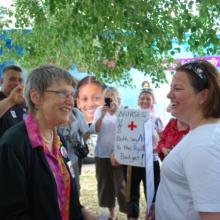american nuns

natrot / Shutterstock
Like many of my millennial peers, I was barely in diapers when the Cold War ended, never practiced fallout drills in school, and only recently learned what those yellow-and-black signs on old buildings meant. As a kid, if I thought about nukes at all, it was in a passive tense, World War II-history sort of way. In other words: not my problem.
But as we mark the 70th anniversary of Hiroshima and Nagasaki — when U.S. aircrafts dropped bombs on two Japanese cities, killing 135,000 people, by conservative estimates — I spent some time in the Sojourners archives trying to fill the gaps in my nuclear education. Here’s what I found.
Three Years After 'Radical Feminist' Charge, U.S. Catholic Sisters and Vatican Reach Peace Agreement
The conflicted and controversial three-year doctrinal investigation by the Vatican of U.S. Catholic sisters in the Leadership Conference of Women Religious has formally come to an end, according to a press release from the Vatican this morning and reports in the National Catholic Reporter.
“We are pleased at the completion of the Mandate which involved long and challenging exchanges of our understandings of and perspectives on critical matters of Religious Life and its practice," said Sr. Sharon Holland, IHM, president of LCWR.
She continued:
"Through these exchanges, conducted always in a spirit of prayer and mutual respect, we were brought to deeper understandings of one another’s experiences, roles, responsibilities, and hopes for the Church and the people it serves. We learned that what we hold in common is much greater than any of our differences.”
Conservative operators within the Vatican have been working for years to bring suspicion on communities of Catholic sisters in the U.S. In the past seven years, they succeeded in launching twin investigations into American nuns.
The first, launched in 2008, was a controversial and unprecedented "apostolic visitation" investigating the finances and communal practices of individual U.S.-based Catholic orders of women religious, representing tens of thousands of women. It ended in December 2014 with a formal backing down by the Vatican office from which it was launched. The final report, issued under Pope Francis, was released at a public press conference in Rome — also unprecedented — in which all those involved made clear statements about the process and emphasized a spirit of forbearance, mercy, and transparency.
The second, launched in April 2012, amounted to a hostile takeover of the Leadership Conference of Women Religious, which represents 80 percent of U.S. Catholic sisters and is the primary leadership governing body for U.S. Catholic women's orders. LCWR was accused by ultra-traditionalist Archbishop Levada of including "radical feminist themes" and fomenting "corporate dissent" from the church's teaching on human sexuality, among other things. Even though LCWR was founded in 1956 under the urging of Pope Pius XII, it was under Pope Benedict XVI that the doctrinal assessment took place.
The Vatican on April 16 officially ended a controversial investigation of American nuns with a face-saving compromise that allows Pope Francis to close the book on one of the more troubled episodes from the pontificate of his predecessor, Benedict XVI.
“We are pleased at the completion of the (investigation), which involved long and challenging exchanges of our understandings of and perspectives on critical matters of religious life and its practice,” Sister Sharon Holland, president of the leadership network of nuns that had been under investigation, said in a statement released following a meeting in Rome with the Vatican’s top doctrinal officials.
“Through these exchanges, conducted always in a spirit of prayer and mutual respect, we were brought to deeper understandings of one another’s experiences, roles, responsibilities, and hopes for the church and the people it serves,” said Holland.
“We learned that what we hold in common is much greater than any of our differences.”
A brief statement from Cardinal Gerhard Mueller, head of the Congregation for the Doctrine of the Faith and leader of the effort to rein in the nuns, who were seen as too liberal, shed little light on what the long-running investigation achieved and seemed aimed at moving past the contentious saga.
Mueller said he was confident that the mission of the nuns “is rooted in the Tradition of the Church” and that they are “essential for the flourishing of religious life in the Church.” The original report had accused the nuns of promoting “certain radical feminist themes incompatible with the Catholic faith.”
In another indicator of the thaw in relations, the delegation of American nuns met later on April 16 with Francis for 50 minutes in a warm encounter that seemed to underscore the sisters’ affinity for the pope’s focus on social justice and on pastoral outreach to the world.
“Our conversation allowed us to personally thank Pope Francis for providing leadership and a vision that has captivated our hearts and emboldened us as in our own mission and service to the church,” the nuns said in a statement.
“We were also deeply heartened by Pope Francis’ expression of appreciation for the witness given by Catholic sisters through our lives and ministry and will bring that message back to our members.”
Last week the Vatican released the final report on its unprecedented investigation of Roman Catholic sisters in the United States. Six years ago, when the Vatican announced the apostolic visitation (its formal name), many of the sisters whom the investigation affected responded with hurt and anger. Now, thanks largely to competent, spiritually grounded leadership on the part of American sisters, the spirit is conciliatory.
When the Vatican launched the investigation in 2008, under Pope Benedict, to “look into the quality of life of religious women in the United States,” the announcement was met with suspicion and apprehension. Since the Vatican had previously only ordered an apostolic visitation when a group had gone astray, sisters wondered what the Vatican wanted to investigate and why. Some congregations reported that their elder sisters felt that their whole lives had been judged and found wanting," remembers Sr. Sharon Holland, president of the Leadership Council of Women Religious, which represents about 80 percent of the 57,000 nuns in the U. S. When Sr. Sandra Schneiders, professor emerita of New Testament and spirituality at the Jesuit School of Theology in Berkeley, Calif., learned of the visitation, she warned sisters to be cautious, treating the visitors as “uninvited guests who should be received in the parlor, not given the run of the house.”
In a situation that could have escalated badly, American sisters rose to the occasion.
Catholic nuns in the U.S. have been thumbing their nose at Rome’s demands to toe the doctrinal line and they need to obey or face serious consequences, the Vatican’s enforcer of orthodoxy said in a surprisingly tough talk to women representing most American sisters.
Mueller said the LCWR — which represents about 80 percent of the more than 50,000 Catholic nuns in the U.S. – is dependent on the Vatican for its bona fides as a church body. He indicated that the group’s status, and the Catholic faith of the sisters, was at risk if they did not heed Rome’s directives.
Since Vatican II American Nuns have worked to fill in the gaps of the American health care system. A new documentary chronicles how these nuns changed the Catholic Church's social justice movement. CNN reports:
"Vatican II was the spark that showed the church isn't just the hierarchy, it's the people," Fishman said. "Sisters from all over the country were inspired to work directly with those that needed their help. These faith-filled people became the most vibrant part of the church who went on to get people excited and passionate about doing God's work and creating real change."
Read more here.
When the Nuns on the Bus pulled up in front of Rep. Paul Ryan’s home office in Janesville, Wis., earlier this week, they were challenging the theological rationale he has been using for his budget plan that has become the economic banner for the Republican Party.
But they were also showing how people can hold strong opinions, get those opinions into the public arena and still engage adversaries in respectful ways.
In the process, they called on citizens to get engaged in the same way.
“I urge you, urge you, I beg you, Janesville, in this election cycle, please, don’t be a spectator,” Sr. Simone Campbell pleaded with a crowd in the courthouse park as their visit to the southern Wisconsin city came to an end.
Relations between the Vatican and the American nuns who are under investigation seem to be worsening after the sisters said on June 18 that initial discussions with Rome about a resolution to their standoff were “difficult” and that comments by several U.S. bishops have not made negotiations easier.
The statement by the board of the Leadership Conference of Women Religious, as well as subsequent remarks by the nun who heads the LCWR, may herald a longer and broader struggle inside the church.
“We have never considered ourselves in any way unfaithful to the church, but if questioning is interpreted as defiance, that puts us in a very difficult position,” Sister Pat Farrell, head of the LCWR, said in an interview with the National Catholic Reporter on Monday.
The Vatican has always been scared of forceful nuns. Even (and perhaps especially) the three female doctors of the church made prelates nervous.
- In the 14th century, Catherine of Siena meddled in papal politics and brought the Avignon pope back to Rome.
- In the 16th century, Teresa of Avila survived an investigation by the Spanish Inquisition of her mystical writings (and Jewish ancestry).
- In the 19th century, Thérèse of Lisieux disregarded the commands of her priest and Vatican officials until the pope gave in and let her do what she wanted.
And last week, following a two-year investigation, 80 percent of American nuns came under Vatican fire.

++ Join us in showing our appreciation for Catholic women religious (aka nuns or "sisters") on Thank-a-Nun Day, May 9. Click HERE to send a thank-you note online. ++
Two long pieces this weekend described "one hell of a killing machine," and "the dark matter





